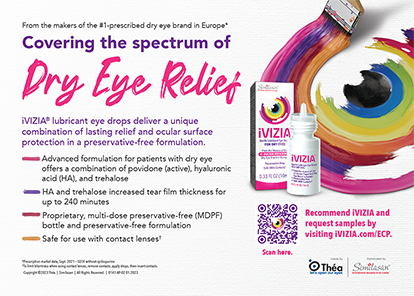Today's Practice | Mar 2006
NSAIDs and Delayed Healing
Recent studies suggest that Nevanac slows epithelial closure and causes postoperative haze when used during surface ablation.
William Trattler, MD, and Juan Carlos Abad, MD
Surface ablation is growing in popularity due to its safety and ability to improve visual acuity. Patients tend to judge the success of the procedure by their level of pain and the speed of their visual recovery. The biggest improvement in surface ablation is our ability to minimize patients' pain via new topical nonsteroidal anti-inflammatory drugs (NSAIDs), topical dilute tetracaine, oral NSAIDs, intraoperative techniques such as frozen BSS to cool the cornea, and next-generation bandage contact lenses. The recent FDA approval of Xibrom (Ista Pharmaceuticals, Inc., Irvine, CA) and Nevanac (Alcon Laboratories, Inc., Fort Worth, TX) now provides surgeons with more options for preventing pain after surface ablation (administering Nevanac for ocular pain management is an off-label use, and the use of Xibrom for pain management after surface ablation is an off-label use).
SURFACE ABLATION AND PAIN
CONTROL WITH NEVANAC
Parameters
In the past, Dr. Trattler has reported the results of a masked, contralateral-eye LASEK study where regimens containing Vigamox (Alcon Laboratories, Inc.), Econopred (Alcon Laboratories, Inc.), and Voltaren (Novartis Pharmaceuticals Corporation, East Hanover, NJ) required 5.5 days for epithelial healing and bandage contact lens removal, compared to regimens containing Zymar (Allergan, Inc., Irvine, CA), Pred Forte (Allergan, Inc.), and Acular (Allergan, Inc.), which required 5.7 days for epithelial healing and bandage contact lens removal.1 Most recently, Dr. Trattler began a study of how Nevanac performed in comparison to Acular LS (Allergan, Inc.) for pain control after surface ablation in 30 patients. Seven patients were enrolled in a head-to-head contralateral study, of which Marguerite McDonald, MD, FACS, of New Orleans was a co-investigator.
In the study, the seven enrolled patients were treated t.i.d. with Zymar, Pred Forte 1%, and a masked topical NSAID in each eye following Epi-LASIK in which the flap was discarded. The first set of drops was placed directly on the stromal bed, followed immediately by the placement of an Acuvue Oasys contact lens (Vistakon Pharmaceuticals, LLC, Jacksonville, FL). Patients also received Parasol punctal plugs (Odyssey Medical Inc., Memphis, TN) on the day of surgery and were pretreated with Restasis (Allergan, Inc.).
The aforementioned regimen did not include a diluted anesthetic. Surprisingly, four of seven eyes treated with Nevanac experienced a significant degree of delayed epithelial healing and subsequently developed corneal haze (Figures 1 to 4). The average time to epithelial healing and the removal of the bandage contact lens was 5.7 days for the Acular LS-treated eyes versus 7.9 for the Nevanac-treated eyes (P=.073). Because of these findings, the investigation was halted at the study site.
Case Study
The patient had a preoperative spherical equivalent of -5.13D OD and -6.25D OS and underwent Customvue treatment with the Visx S4 laser (Advanced Medical Optics, Inc. Santa Ana, CA). She was comfortable throughout her early postoperative course. On postoperative day 5, she returned for an evaluation. The epithelium in her right eye had healed, and the bandage contact lens was removed. However, a large epithelial defect was present in her left eye. The NSAIDs were discontinued in both eyes. During the next 4 days, the epithelial defect slowly closed. On postoperative day 9, the epithelium had closed enough to allow the removal of the bandage contact lens. Her anti-infective therapy was discontinued, and she continued taking the steroid q.i.d. and restarted taking Restasis b.i.d. At 1 month postoperatively, her right cornea was clear, although her left cornea demonstrated 2+ corneal haze. She continued administering Pred Forte drops in this eye. At 2 months postoperatively, her right cornea was clear and achieved a BCVA of 20/20. Her left eye had 2+ corneal haze and a BCVA of 20/30. Unmasking the key revealed that she had received Acular LS in her right eye and Nevanac in her left.
PRK AND PAIN CONTROL WITH NEVANAC
Technique
Dr. Abad's PRK technique (alcohol-assisted epithelial removal with an 8.0-mm optical zone marker, a mitomycin C [MMC] sliding scale, and a bandage Soflens 66 [Bausch & Lomb, Rochester, NY]) has been the same for the last 2 years. Postoperatively, the patients receive Pred Forte, Zymar, and dilute proparacaine. No NSAIDs are administered after surgery. Dr. Abad performs PRK in patients with thin corneas or borderline-looking topographies (20% to 25% of all excimer cases).
He started using one drop of Nevanac at the end of PRK cases (before the placement of a contact lens) in November 2005 to try to improve pain control. He applied only one drop of Nevanac postoperatively.
Dr. Abad analyzed a series of 10 bilateral PRK cases in which Nevanac was used as mentioned earlier. He noticed persistent epithelial defects, grayish “sick-looking” epithelium, and poor visual acuity in those patients postoperatively. On December 13, 2005, he stopped using Nevanac, scraped three eyes (one patient bilaterally), and posted his findings on the International Society of Refractive Surgery Internet forum as an alert to the ophthalmic community. Since then, Dr. Abad has returned to his traditional PRK regimen.
As a control group, he used his last five bilateral PRK patients treated before Nevanac was used (historic controls) and the five subsequent bilateral PRK patients treated after Nevanac was used (all consecutive patients). In the control group, re-epithelialization occurred by 4.7 days (mean). Mean haze at 1 month postoperatively was 0.2 out of 4. In the Nevanac group, re-epithelialization on average occurred by day 9 postoperatively (P<.001). Mean haze at 1 month postoperatively was 1.3 out of 4 (P<.001).
The three previously mentioned Nevanac eyes that had the epithelium removed had clear stroma underneath, and the maneuver hastened their epithelial healing.
The haze in the Nevanac eyes was still present at the
3-month follow-up. One Nevanac patient is scheduled for a MMC-assisted scraping for severe haze and poor BCVA. The controls have had an unremarkable postoperative course.
Case Study
A 24-year-old female underwent Customvue bilateral PRK with a Visx S4 laser. Preoperatively, she had a refractive error of -4.00 -2.00 X 180 with a BCVA of 20/20 OU. She received Dr. Abad's intraoperative regimen mentioned earlier. Epithelial healing was delayed in both eyes, despite postoperative autologous serum drops, until 11 days after surgery (Figure 5). On postoperative day 12, the epithelium reopened in her right eye (Figure 6), and she underwent a superficial keratectomy. At 2 months postoperatively, the patient continued to exhibit visually significant haze (2+ to 3+) despite a 15-second intraoperative application of MMC. Her BCVA was 20/30 OU (Figure 7).
DISCUSSION
As these cases demonstrate, Nevanac applied directly to the stromal bed can impede epithelial healing and cause corneal haze. Interestingly, although Dr. Trattler prescribed Nevanac after surgery, Dr. Abad did not have patients use any type of NSAID drop during the postoperative period. Other surgeons, including
Jeff Gold, MD, and Tom Claringbold, MD (J Gold [jgold2@comcast.net], e-mail, January 14, 2006; and
T Claringbold [eyeboy@mail.tm.net], e-mail, January 23, 2006), have described similar experiences with Nevanac when using it on the stromal bed.
Daniel Durrie, MD, and others have reported that they have not observed delayed epithelial healing after surface ablation. They used Nevanac after the placement of a contact lens for a short period of time (typically for 48 hours), and delays in epithelial healing had not occurred. The difference in epithelial healing with this switch in routine is interesting.
The following recommendations are based on our experience.
1. Avoid applying Nevanac to the stromal surface prior to placing a contact lens after surface ablation.
2. Limit the use of Nevanac to the first 48 hours after laser ablation when using the drug for the prevention of postoperative pain.
3. If a delay in epithelial healing occurs, make every effort to encourage its rapid resolution. Steps include stopping the topical NSAID and placing punctal plugs. Once the epithelium has healed, care must be taken to identify haze, which should receive aggressive treatment with topical steroids.
Continuing studies will provide ophthalmologists with a better understanding of the off-label use of Nevanac and its optimal application with laser vision correction procedures. In the mean time, surgeons should be aware of the delayed epithelial closure and postoperative haze associated with Nevanac when it is applied directly to the stromal bed.
William B. Trattler, MD, is a corneal specialist at the Center for Excellence in Eye Care in Miami and a volunteer assistant professor of ophthalmology at the Bascom Palmer Eye Institute in Miami, Florida. Dr. Trattler is a paid consultant to Allergan, Inc., and Alcon Laboratories, Inc. He has received research support from Allergan, Inc., and Alcon Laboratories, Inc., and he has received honoraria for participating in roundtables and focus groups for Ista Pharmaceuticals, Inc. Dr. Trattler may be reached at (305) 598-2020; wtrattler@gmail.com.
Juan Carlos Abad, MD, practices anterior segment, corneal, and refractive surgery at the Laser Eye Center of Miami. He acknowledged no financial interest in any product or company mentioned herein. Dr. Abad may be reached at (305) 443-4733; jcabad@gmail.com.
1. Durrie DS and Trattler W. A comparison of therapeutic regimens containing moxifloxacin 0.5% ophthalmic solution and gatifloxacin 0.3% ophthalmic solution for surgical prophylaxis in patients undergoing LASIK or LASEK. J Ocul Pharmacol Ther. 2005;21:236-241.




